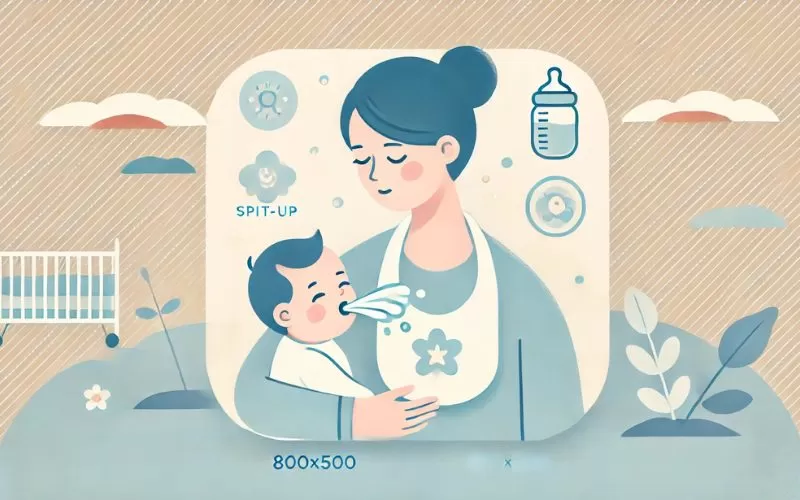Table of Contents
Spit-Up Reflux During Feeding
Spit-up and reflux are common issues that most parents face during their baby’s early months. Although it can be messy and sometimes worrying, spit-up is usually a normal part of a baby’s development. Understanding why babies spit up, learning how to manage it, and finding the right products to help can make feeding times more enjoyable and less stressful. In this guide, we’ll dive into the causes of spit-up, how to handle it, and suggest some helpful products to make your life easier.
For parents navigating the challenges of spit-up and reflux, understanding the underlying causes and effective management strategies is essential. A valuable resource that provides comprehensive insights on this topic is HealthyChildren.org, which discusses symptoms, treatment options, and tips for feeding infants with reflux. This guide is a great reference for ensuring your little one gets the care they need while minimizing discomfort.
Why Babies Spit Up: Causes and What You Should Know
Why babies spit up is a question every parent asks, especially when it seems to happen frequently. Spit-up usually occurs when the contents of the stomach are regurgitated into the esophagus and sometimes out of the mouth. The primary cause of this is the immaturity of a baby’s digestive system, particularly the lower esophageal sphincter, which is not yet fully developed. Here are some common reasons why spit-up happens:
- Underdeveloped digestive system: The muscles between the stomach and esophagus in babies are still growing, making it easier for milk or formula to flow back up.
- Overfeeding: When babies are given more milk than their small stomachs can handle, spit-up becomes more likely.
- Feeding position: Feeding a baby while they’re lying flat can increase the chances of spit-up.
- Swallowing air: Babies tend to swallow a lot of air while feeding, which can cause burping and spit-up.
Most babies will outgrow spit-up by the time they’re around 6 to 12 months old, but in the meantime, there are ways to manage it effectively. For example, using our Anti-Reflux Feeding Pillow can keep your baby in an elevated position, reducing the likelihood of spit-up during and after feeding.
As your baby grows, you might be concerned about managing spit-up and reflux, especially during feeding transitions. One significant milestone is introducing solids into your baby’s diet, which can sometimes help reduce reflux symptoms. However, it’s important to introduce new foods carefully and in a stress-free manner. If you’re unsure where to start, check out our comprehensive guide, Introducing Solids Without the Stress: A Guide for Parents, to help you navigate this process with confidence and ease.
How to Deal With Your Baby’s Spit-Up: Practical Solutions

Dealing with your baby’s spit-up doesn’t have to be stressful. By making a few adjustments to your feeding routine, you can minimize the frequency and impact of spit-up. Here are some practical tips to help manage spit-up during feeding:
- Feed smaller amounts more frequently: Instead of large meals, give your baby smaller, more frequent feeds. This prevents overloading their small stomachs and reduces the risk of spit-up.
- Keep your baby upright after feeding: Hold your baby in an upright position for about 20 to 30 minutes after feeding to help with digestion and prevent milk from flowing back up.
- Burp your baby frequently: Burping helps release any air your baby may have swallowed during feeding, which can contribute to spit-up.
For easier cleanup, especially after burping, it’s handy to have our Organic Cotton Burp Cloths nearby. These ultra-soft cloths are not only absorbent but also gentle on your baby’s delicate skin, making them a must-have for spit-up management.
Your Baby: Spitting Up and Vomiting – Knowing the Difference

It’s important to differentiate between your baby: spitting up and vomiting. While spit-up is generally harmless and expected, vomiting can sometimes indicate a more serious issue. Here’s how to tell the difference:
- Spit-up is usually a small amount of milk that comes up soon after feeding and doesn’t seem to bother your baby.
- Vomiting, on the other hand, is more forceful and may come out in larger amounts. It can sometimes be projectile and may be accompanied by discomfort, crying, or other symptoms.
If you notice your baby vomiting frequently, particularly if it’s accompanied by weight loss, dehydration, or irritability, it’s important to consult with your pediatrician to rule out conditions like gastroesophageal reflux disease (GERD).
Signs of normal spit-up:
- Occurs shortly after feeding.
- Doesn’t cause your baby discomfort.
- Is typically small in volume and mostly consists of milk or formula.
Signs of vomiting:
- Projectile or forceful.
- May contain green or yellow fluid.
- Occurs frequently and is accompanied by fussiness or distress.
Using products like our BPA-Free Anti-Colic Bottles, which are designed to reduce the amount of air swallowed during feeding, can help lower the frequency of spit-up and discomfort. These bottles have special vents that prevent air from mixing with the milk, making feedings smoother for your baby.
Common Causes of Reflux in Babies

Along with spit-up, reflux is another common issue that parents face. Reflux occurs when food or liquid from the stomach flows back into the esophagus, which can cause discomfort or mild pain for your baby. It’s often linked to spit-up but can also be a more serious issue if it leads to frequent vomiting or irritability. Here are some common causes of reflux in babies:
- Immature digestive system: As mentioned earlier, babies are born with an immature lower esophageal sphincter, which allows food to flow back up more easily.
- Overeating: Like with spit-up, overfeeding can cause reflux by overloading the stomach.
- Allergies or intolerances: Some babies may have a mild allergy or intolerance to certain proteins in formula or breastmilk, which can worsen reflux symptoms.
By adjusting feeding techniques and using specially designed products like the Anti-Reflux Feeding Pillow, you can help reduce reflux episodes. This pillow helps keep your baby’s head elevated, which can prevent the stomach contents from flowing back into the esophagus.
Transitioning from breastfeeding to bottle-feeding can be a big step for both parents and babies. It’s essential to make the process gradual and comfortable for your little one. Start by introducing the bottle during a calm feeding time and using a bottle nipple that mimics the breast to ensure a smooth adjustment. Additionally, keep the bottle warm and hold your baby close to recreate the comforting experience of breastfeeding. If you’re looking for high-quality bottles and transition-friendly feeding supplies, check out our Breast to Bottle: Tips for Transitioning to Bottle Feeding to help make the shift seamless.
How to Deal With Your Baby’s Spit-Up: Expert Tips for Reducing Mess
One of the biggest concerns for parents dealing with spit-up is managing the mess it leaves behind. Here are some expert tips for keeping spit-up under control and reducing the need for frequent cleanups:
- Use bibs and burp cloths: A simple but effective way to deal with spit-up is by using a bib during feeding and a burp cloth during burping. Our Reusable Bibs with Adjustable Straps are not only comfortable for your baby but also super absorbent, making them perfect for catching spit-up before it reaches your baby’s clothes.
- Position your baby properly: Keeping your baby in an elevated position during feeding can help reduce spit-up. Using a pillow or gently holding them upright can assist with better digestion.
- Monitor feeding times: Try to avoid feeding your baby too quickly or too close to bedtime, as this can increase the chances of spit-up.
Additionally, make sure to burp your baby regularly during feeding breaks to prevent air buildup. The BPA-Free Anti-Colic Bottles are a great tool to reduce air intake, minimizing the discomfort that leads to spit-up.
Why Babies Spit Up: Final Thoughts on Managing Spit-Up

In understanding why babies spit up, it’s important to remember that it’s a normal part of development for most infants. Although it can be frustrating, particularly when it’s frequent, it’s rarely something to worry about. Managing spit-up is all about patience, the right feeding practices, and using helpful products.
Investing in high-quality baby care items like our Anti-Reflux Feeding Pillow, Organic Cotton Burp Cloths, and Reusable Bibs can make spit-up much easier to manage. These products are designed to reduce the frequency of spit-up and make cleanups much simpler for parents.
Your Baby: Spitting Up and Vomiting – When to Seek Help
As mentioned, spit-up is usually nothing to worry about, but if you notice more serious symptoms, such as vomiting, it’s essential to seek medical advice. Pay attention to how often your baby vomits, and if it’s accompanied by other symptoms such as weight loss, irritability, or dehydration, consult your pediatrician immediately. Your baby: spitting up and vomiting can sometimes signal a condition like GERD, which may require further treatment or dietary changes.
How to Deal With Your Baby’s Spit-Up: Recap of Strategies
Managing your baby’s spit-up is all about being prepared. Here are some key strategies to keep in mind:
- Feed smaller amounts more frequently: This helps prevent overfeeding and reduces the chances of spit-up.
- Keep your baby upright after feeding: Hold your baby in an upright position to help with digestion.
- Use specialized products: Items like the BPA-Free Anti-Colic Bottles and the Anti-Reflux Feeding Pillow can reduce the occurrence of spit-up by minimizing air intake and keeping your baby elevated.
Conclusion
Dealing with spit-up and reflux during feeding can be a challenge, but with the right knowledge and tools, you can handle it with ease. Understanding why babies spit up, knowing the difference between normal spit-up and vomiting, and using the right products will make feeding time more enjoyable and less stressful. Remember that most babies will outgrow spit-up as their digestive systems mature, but in the meantime, being prepared is your best defense.
Products like the Anti-Reflux Feeding Pillow, Organic Cotton Burp Cloths, and BPA-Free Anti-Colic Bottles are excellent options to make feeding and cleanup easier, reducing the stress of frequent spit-up.
By incorporating these strategies and tools into your routine, you can confidently manage your baby’s spit-up and vomiting, ensuring a comfortable and happy feeding experience for both you and your baby.
Dealing with spit-up and reflux during feeding can be challenging, but establishing a solid breastfeeding routine can help minimize these issues. Ensuring your baby has a good latch and feeding position is crucial in reducing the chances of reflux. If you’re just starting your breastfeeding journey or looking for helpful tips to improve your experience, check out our Breastfeeding Guide: How to Get Off to a Great Start for expert advice on setting a strong foundation for successful breastfeeding.

